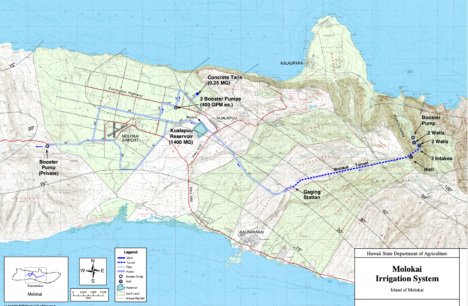122% Rate Increased Proposed for MIS
By Jack Kiyonaga, Editor

Map courtesy of Hawaii State Dept of Agriculture.
The Molokai Irrigation System (MIS) funnels water from the green slopes of Waikolu Valley to the hills of Ho’olehua, where it feeds thousands of acres of homesteads and farms. Some of Molokai’s biggest farms including Bayer, Coffees of Hawaii and the Ag Park, as well as homestead residents, rely exclusively on the MIS. Now, the Department of Agriculture is proposing a 122 percent rate increase for the system.
An increase of 122 percent means that a monthly bill of $500 would become $1,100.
The steep rate increase will pay for replacing the water meters, repairs in Waikolu Valley, and other capital improvement projects, according to Kirk Saiki, an engineering program manager for the Department of Agriculture.
Rates have not been increased since the 2006-11 period, when they were raised from $0.32 per gallon to $0.50.
“We try and hold off as long as possible to keep the rates as low as possible,” said Saiki.
However, the increase could take a heavy toll on local agriculture.
“It’s a huge issue,” said Glenn Teves, a University of Hawaii extension agent as well as a Ho’olehua homesteader and farmer. “The cost of farming on Molokai is much higher than any other islands because we have to pay additional freight costs.” These costs “make us non-competitive unless you have a really unique product,” he added.
Teves explained that the MIS has a distinguished, and somewhat contentious, history.
“When the system was built, it was a wonder,” he said.
Completed in the 1960s, the MIS pumps water through a five-mile tunnel before depositing it in the 1.4-billion-gallon Kualapu’u Reservoir. From there, the water feeds over 25 miles of irrigation system.
According to Teves, the system was created for homesteaders as part of the Hawaiian Homes Commission Act of 1920, which secured water “free of charge” for Native Hawaiians. As the system was constructed however, farms were added to the users, in part to pay for federal loans during MIS construction.
The MIS rate should just be for the cost of transmission, explained Teves. Instead, “we’re paying way more than just the cost of transmission.”
In fact, according to Teves, Molokai pays more than its fair share already. Since the 1980s, he explained, MIS revenue has been used to pay for similar irrigation systems on other islands.
“A 122 percent proposed increase, I think that should be off the table,” said Denise Kawano, general manager of the Hikiola Cooperative, of which almost 100 farmers and ranchers on Molokai are members.
According to Kawano, an increase of this proportion could “most definitely” lead to the closure of many Molokai farms.
“I know an increase is inevitable,” said Kawano, but, she added, “I hope they can look for expense reduction before they jump on price increases.”
Saiki is helping create a response to a virtual public hearing held on Aug. 22 regarding the rate increase. He is currently analyzing testimony before taking it to the Board of Agriculture.
“When we get to the point of not being able to be self-sustaining, we let the board know that rates need to be increased,” said Saiki.
However, the MIS has received over $11 million in the last three years from the state, specifically for capital improvement projects.
“In reality what [the rate increase proposal] is, it starts the talking process between us, the legislature and everybody else to figure out how to fund either more money from the state or how do we fund the increased costs,” said Saiki.
As for concerns that higher rates will push farmers out of business, “yes,” said Saiki, acknowledging fears, but added that “all I can say is that it’s not going to happen tomorrow.”
With testimony from the public hearing, Saiki explained that “now we have issues we can address to the board.”
From there, the board will decide what will happen with rates.
While Saiki said that the Department of Agriculture will alert MIS customers when a final decision about rates has been reached, there is currently no timeline in place for when that decision will be made.











Don't have a Molokai Dispatch ID?
Sign up is easy. Sign up now
You must login to post a comment.
Lost Password